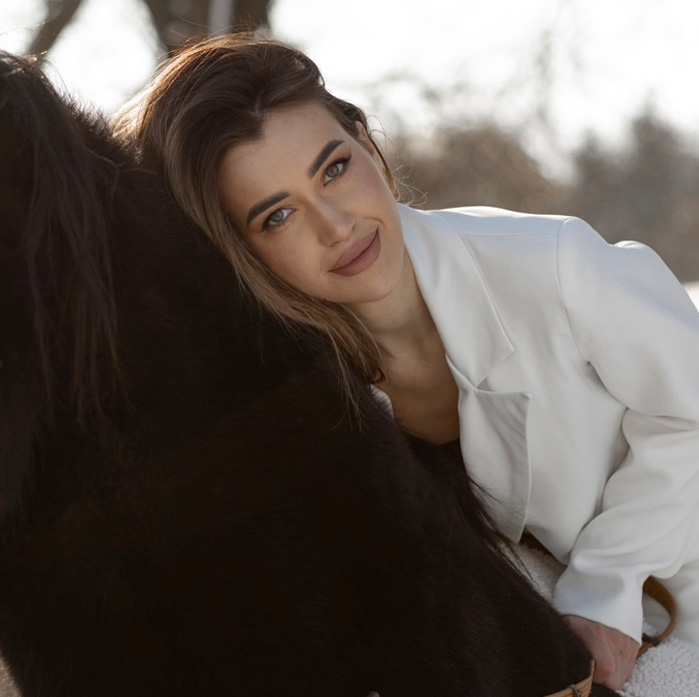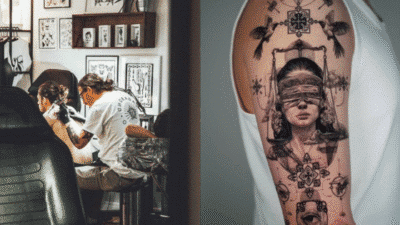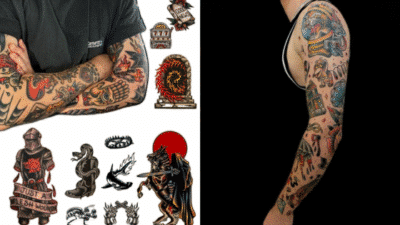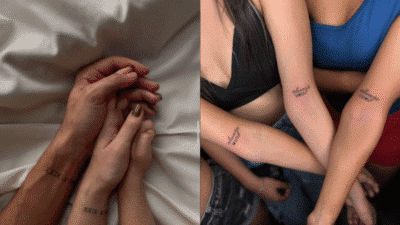
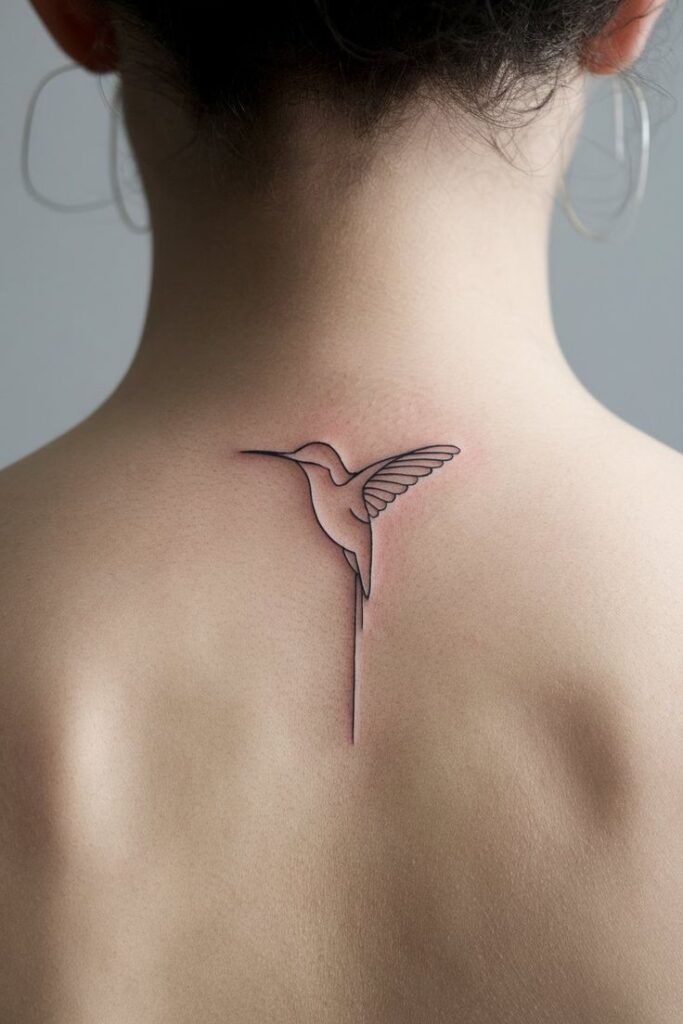
Outline tattoo drawings are simple yet powerful designs made with clean lines and no shading. They work well for anyone who wants a clear, stylish tattoo that highlights form and shape without extra detail. These tattoos can range from small symbols to larger, more complex images.
Many people choose outline tattoos because they are easy to customize and can be adapted to fit different styles and meanings. The straightforward look makes them popular among those who prefer a minimalist or modern feel. Whether someone wants nature-inspired art or abstract shapes, outline tattoos offer many options.
Choosing the right design and artist is are important step for a successful tattoo. A skilled artist will make sure the lines are smooth and the design fits perfectly on the skin. Proper care after getting the tattoo helps keep the lines sharp and the skin healthy.
Key Takeaways
- Outline tattoos focus on clean lines with no shading or color.
- They are easy to customize to fit different styles and personal meanings.
- Picking a skilled artist and proper aftercare helps maintain the tattoo’s quality.
Popular Outline Tattoo Drawing Ideas
Outline tattoos use simple lines to create clear and stylish images. Some designs focus on natural beauty, while others highlight structure or form. Each type offers unique looks that fit different tastes and meanings.
Floral Motifs


Floral outline tattoos often show single flowers or small bouquets. Common flowers include roses, lilies, and daisies. These tattoos use thin lines to highlight petals and leaves without shading or color.
They appeal to those who want delicate, feminine designs. Flowers can symbolize growth, love, or new beginnings. The simplicity of outlines helps keep the tattoo subtle yet elegant.
Many floral tattoos fit small areas like wrists or ankles. Others can be larger, covering arms or shoulders with detailed line work to show the natural shape of each flower.
Animal Outlines


Animal outline tattoos capture the shape and form of creatures with minimal detail. Popular animals include wolves, cats, birds, and elephants. These designs focus on the outline only, avoiding shading or color.
They often represent traits like strength, freedom, or loyalty. For example, a wolf outline might stand for bravery or family bonds. Bird outlines can symbolize freedom or hope.
These tattoos work well on various body parts, such as forearms or calves. The simple lines make the animal easy to recognize and allow for flexible sizing.
Geometric Shapes


Geometric outline tattoos use clean lines to create shapes like triangles, circles, and hexagons. Complex designs combine these forms to build patterns or abstract images.
They appeal to people who like modern, minimal art. These shapes often symbolize balance, harmony, or stability. Some designs also create illusions or 3D effects using only outlines.
These tattoos fit well on areas like hands, wrists, or backs. They look neat and sharp because of the clear edges, and the style is easy to customize with different shapes.
Nature-Inspired Designs


Nature-inspired outline tattoos show trees, mountains, waves, and clouds using simple lines. These images suggest calmness, adventure, or a connection to the outdoors.
Tree outlines may include bare branches or full leaves, focusing on the silhouette. Mountain designs highlight peaks and angles with crisp line work.
They suit people who enjoy minimal art that also has deep personal meaning. These tattoos often fit larger spaces like the chest or back to show the full outline clearly.
Minimalist Outline Tattoo Concepts
Minimalist outline tattoos focus on clean lines and simple forms. They rely on minimal detail to create meaningful images. These designs work well for people who want subtle, elegant tattoos.
Single Line Art


Single-line art tattoos use one continuous line to form a design. This style keeps the image simple yet striking. The line rarely crosses itself, creating a smooth flow that connects all parts of the tattoo.
Common themes include faces, animals, and plants. Artists focus on capturing the essence of the subject with as few lines as possible. This type of tattoo often looks delicate but holds a strong visual impact.
Tiny Silhouette Tattoos


Tiny silhouette tattoos are small, filled shapes outlined clearly. They tend to represent simple objects like hearts, stars, or animals. The filled silhouette contrasts with the outline, making the design stand out on small skin areas.
These tattoos suit people who want something discreet but noticeable. Because they are small and straightforward, they work well on fingers, behind ears, or wrists. They require less time to ink and heal faster.
Abstract Figures


Abstract figures use outline shapes to suggest forms without clear details. These designs might look like unusual shapes or symbols. The focus is on the balance and flow of the lines.
This concept appeals to those who prefer a unique and personal design. Abstract outlines can represent emotions or ideas without obvious imagery. It allows for creative freedom while staying minimal and clean.
Customizing Outline Tattoo Drawings
Customizing outline tattoos involves adding personal touches, mixing different ideas, and choosing the right spot on the body. Each of these steps helps make the tattoo unique and fitting for the person getting it. These details shape the final design and how it looks on the skin.
Personal Meaning Integration


Adding personal meaning to an outline tattoo makes it more special. People often include symbols that represent important events, values, or loved ones. For example, a simple outline of a bird could stand for freedom or a family connection.
Names, dates, or small icons can be added inside or near the main outline. This makes the tattoo more than just a picture—it tells a story. Discussing ideas with a tattoo artist helps find ways to blend meaning without cluttering the design. Personal meaning should feel clear, but also keep the tattoo clean and simple.
Combining Elements

Outline tattoos can be combined with other styles or symbols to create a unique look. Mixing floral shapes with geometric lines is common because it adds depth without losing simplicity. Small, connected icons can also tell a bigger story.
People often layer outlines of animals, nature, or abstract shapes. Using thin lines for one element and bolder ones for another creates contrast. However, the mix should stay balanced to avoid confusion. Clear boundaries between elements help each part stand out.
Placement Considerations


Choosing the right place for an outline tattoo affects how visible it is and how it ages. Areas with less movement, like the upper arm or back, help keep outlines sharp longer. Skin that stretches a lot can cause lines to blur or distort.
Size matters too—a small outline on a finger needs simpler shapes than one on a larger area like the chest. Pain tolerance and personal lifestyle influence placement choices. A well-chosen spot enhances the tattoo’s look and ensures the design stays clear over time.
Tips for Drawing Outline Tattoos
Creating clean, sharp outlines requires attention to the right tools, steady techniques, and regular practice. Using proper materials helps achieve precision, while specific methods keep lines neat. Repeatedly sketching improves control and confidence.
Tools and Materials
Good outline tattoos start with the right supplies. Artists often use fine-tip pens or markers for practice, choosing ones that don’t smudge easily. A smooth, thick paper helps prevent ink bleeding.
For digital work, tablets with pressure sensitivity allow consistent line weight. Pencil and eraser sets are useful for initial sketches and corrections before inking.
Keeping tools clean is crucial. Dull pens or dirty tips can cause uneven lines. Sharp pencils and fresh ink always produce better results.


Techniques for Clean Lines
Steady hands are key to clean outlines. Artists use long, confident strokes instead of many short ones to avoid shakiness. Drawing slowly and keeping the wrist stable helps maintain control.
Holding the pen at a consistent angle produces even lines. Starting with light pressure and increasing it slightly prevents thick spots.
Using a ruler or stencil can help with straight or curved lines. Resting the arm on a surface reduces jittering, especially on detailed areas.
Practicing Sketches


Regular sketching builds muscle memory. Artists practice simple shapes repeatedly to improve line steadiness. They often copy existing outline tattoos to study form and flow.
Using different pen sizes in practice helps control line thickness. Practice on various paper types teaches how materials affect lines.
Timed exercises, like drawing shapes within specific times, improve speed and accuracy. Keeping a sketchbook for daily practice tracks improvement over time.
Trendy Outline Tattoo Styles
Outline tattoos today vary in style, focusing on clean lines and simple forms. Each style uses different techniques to bring out unique visual effects in tattoos.
Fine Line Tattoos


Fine line tattoos use very thin lines, often less than one millimeter wide. This style is popular for delicate and detailed designs like flowers, small animals, or symbols.
Artists need steady hands and sharp needles to create these tattoos. The thin lines make the tattoos look light and elegant. They work well on small areas such as wrists, ankles, or behind the ear.
Fine line tattoos usually fade more slowly than thicker line tattoos because they take up less skin area. However, touch-ups might be needed to keep the lines crisp over time. People often choose this style for minimalistic and subtle tattoos.
Continuous Line Tattoos


Continuous line tattoos are made with one single, unbroken line that forms a full image. This style stands out for its simplicity and creative flow.
Because the design never lifts from the skin, it creates a smooth and connected look. These tattoos can represent faces, animals, or abstract shapes.
This style requires skill to keep the line consistent in thickness and avoid breaks. Continuous line tattoos are often larger to show off the full form clearly, but can also be small and simple.
Dotwork Outline Designs


Dotwork tattoos use tiny dots instead of solid lines to create an outline. The dots vary in spacing and size to form shades and depth within the outline.
This style adds texture and dimension, making the tattoo look detailed from up close. Popular designs include mandalas, geometric shapes, and nature-inspired art.
Dotwork can take longer to tattoo because of the precision needed for each dot. It suits those who want their outline tattoos to have a unique feel, balancing between line art and shading.
| Style | Key Feature | Best For |
|---|---|---|
| Fine Line Tattoos | Very thin lines | Small, delicate designs |
| Continuous Line Tattoos | One unbroken line | Flowing, simple shapes |
| Dotwork Outlines | Dots form the outline | Textured, detailed art |
Choosing the Right Tattoo Artist

Finding the right tattoo artist is important for a clean outline tattoo. The artist should have experience with fine lines and simple designs. This skill helps to keep the lines sharp and clear over time.
People should look at the artist’s portfolio before booking. A good portfolio shows past outline tattoos. It also shows consistency in line work and detail. This helps to judge if the artist fits the desired style.
It is helpful to read reviews from past clients. Reviews often mention how clean and steady the artist’s lines are. They also highlight the artist’s professionalism and hygiene.
When meeting the artist, people should ask questions about their process. They can ask how they handle line thickness or pain control. Understanding the artist’s approach builds trust.
Price should not be the only factor. Cheaper tattoos might risk poor quality. It is better to pay more for someone skilled in outline work.
The tattoo shop’s cleanliness matters too. A clean shop reduces the chance of infection. This keeps the tattoo safe during healing.
In short, a good outline tattoo comes from an artist with skill, experience, and care. Taking time to choose the right person helps the tattoo look its best.
Aftercare for Outline Tattoos

After getting an outline tattoo, it is important to keep the area clean. Gently wash the tattoo with mild soap and lukewarm water. Avoid scrubbing or using rough cloths.
The tattoo should be patted dry with a clean towel. Do not rub the skin as it can cause irritation or damage.
A thin layer of ointment or moisturizer recommended by the artist should be applied. This helps keep the skin hydrated and supports healing.
Avoid direct sunlight on the tattoo until it heals fully. Sun exposure can fade the ink and delay healing.
It is best to avoid swimming, hot tubs, or soaking the tattoo in water. Excess moisture can cause infection or ink loss.
Wearing loose clothing around the tattoo site will reduce friction and irritation.
If the tattoo itches, do not scratch. Light tapping or applying moisturizer can help ease the itch.
Signs of infection include redness, swelling, pus, or severe pain. If any of these occur, a doctor should be contacted.
Following the aftercare steps helps keep the lines crisp and clear. Proper care ensures the outline tattoo heals well and lasts longer.
Conclusion
Outline tattoo drawing ideas offer a simple and clean style. They focus on shapes and lines without heavy shading or color. This makes them versatile and easy to customize.
People often choose outline tattoos for their subtle and minimal look. They work well on any part of the body and suit many themes. From animals to symbols, outlines can capture clear and distinct images.
When picking an outline tattoo, it is important to consider size and detail. Smaller tattoos need less complex designs to stay clear. Bigger tattoos can hold more detail while keeping the outline sharp.
It helps to find a skilled tattoo artist who specializes in fine lines. Good line work is key to keeping the tattoo lasting and looking good over time.
Below is a quick list of common outline tattoo ideas:
- Geometric shapes
- Floral designs
- Animals
- Symbols and icons
- Minimal portraits
Choosing the right outline tattoo depends on personal taste and meaning. It is a style that remains popular for its simplicity and ease of recognition.
What are outline tattoos, and what makes them distinctive?
Outline tattoos are characterized by simple, powerful designs made with clean lines and no shading. They highlight the form and shape of the image without additional detail, making them clear and stylish.
Why are outline tattoos considered versatile and popular?
Outline tattoos are easy to customize, adaptable to different styles and meanings, and suitable for a variety of themes like nature, symbols, or abstract art, which contributes to their popularity.
How can one ensure the quality of an outline tattoo?
Choosing a skilled tattoo artist with experience in fine lines and simple designs is essential, as their expertise ensures the lines are smooth, accurate, and lasting.
- 670shares
- Facebook0
- Pinterest670
- Twitter0
- Reddit0
